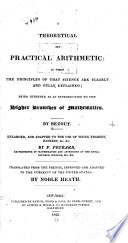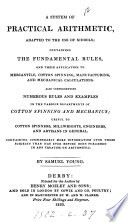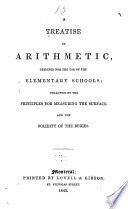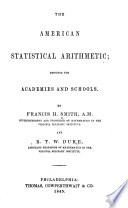 | John Mair - Arithmetic - 1772 - 376 pages
...the fum of the extremes. The it-cond part of the proportion is likewife plain : for, by Theorem V. the difference of the extremes, divided by the number of terms minus unity, quotes the eornmon difference ; but the quote multiplied into the di vifor, produces the dividend... | |
 | Beriah Stevens - Arithmetic - 1822 - 436 pages
...the common difference into the number of tor. as minus unity. THEOREM 5. In an arithmetical series, the difference of the extremes, divided by the number of terms minus unity, quotes the common difference. Thus, in the series, 3, 5, 7, 9, 11, 13, the difference of the... | |
 | Bézout - Arithmetic - 1825 - 258 pages
...Dividing the two equalities by the number of the terms, diminished by a unit, we shall have the difference equal to the difference of the extremes divided by the number of the terms diminished by a unit ; that is to say : , •»— a d= -. n— 1 For example, if between... | |
 | Samuel YOUNG (of Manchester.) - 1833 - 272 pages
...Theorem. The sum of the extremes is equal to the sum of any two means equally distant from them. PROBLEM I. Given the extremes and number of terms to find...divided by the number of terms minus one. And the sum of the series is equal to the sum of the extremes multiplied by half the number of terms. (1) Given... | |
 | Silas Totten - Algebra - 1836 - 360 pages
...value of q, we shall have, I — a q = ^=\, or, the common difference of an arithmetical progression, equal to the difference of the extremes divided by the number of terms less 1. (83.) In order to find the sum of any number of terms of an arithmetical progression, let &... | |
 | Arithmetic - 1843 - 142 pages
...the sum of any two meansequally distant from them. PROBLEM I. Given the extremes and number of term?, to find the other two. • RULE. The common difference...divided by the number of terms minus one ; and the sum of the series 13 equal to the sum of the extremes multiplied by half the number of terms. 1. Given... | |
 | Francis Henney Smith - Arithmetic - 1845 - 710 pages
...difference taken as many times less 1 as there are terms, it follows, that the common difference will be equal to the difference of the extremes divided by the number of terms less 1 . EXAMPLES. 1. Find the common difference in the arithmetical series whose first term is 3,... | |
 | Joseph Ray - Algebra - 1848 - 250 pages
...transposing a, and dividing by n — 1, we find d= - , . n— 1 That is, in any arithmetical series, the common difference is equal to the difference of the extremes, divided by the number of terms les.' one. Examples, illustrating these principles, will be found in the collection at the close of... | |
 | Joseph Ray - Algebra - 1848 - 252 pages
...consisting of »i+2 terms. But, by the preceding principle, the common difference of this series will be equal to the difference of the extremes divided by the number of terms less one ; that is, d= — rg — :-= — —. ; therefore, the common difference wi-f-* — 1 m-\-... | |
 | Joseph Ray - Algebra - 1848 - 250 pages
...transposing a, and dividing by n — 1, we find d= - T. n — 1 That is, in any arithmetical series, the common difference is equal to the difference of the extremes, divided by the number of terms less one. Examples, illustrating these principles, will be found in the collection at the close of... | |
| |